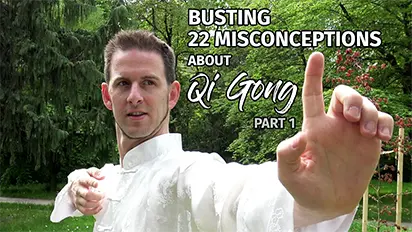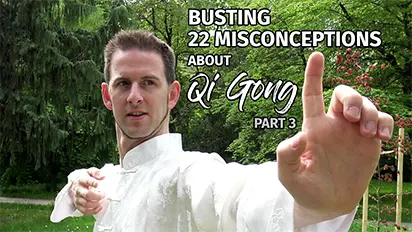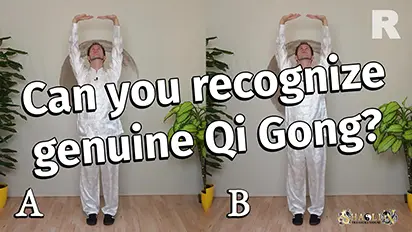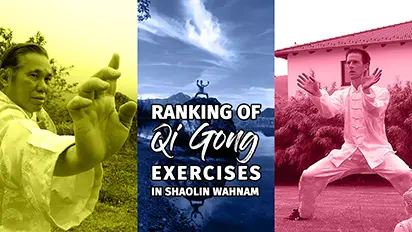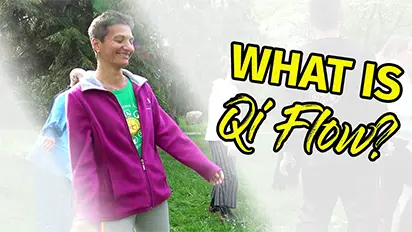Busting 22 Misconceptions About Qi Gong - Part 2/3
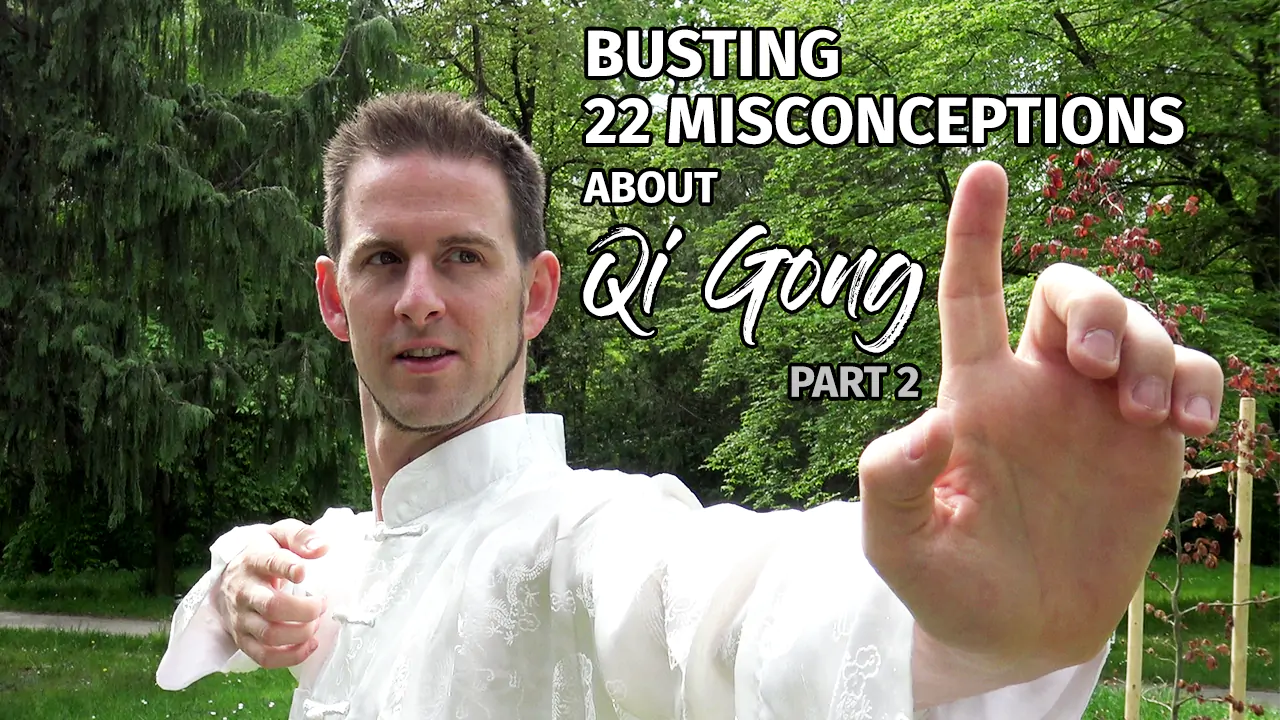
Back again with some more common wrong believes and misconceptions about Qi Gong, its principles and teaching methodologies.
In part 1 of this series you learned that not all Qi Gong is the same and that it is taught and practiced at vastly different levels.
But one article is not enough to cover all the many persistent misunderstandings that surround this beautiful and transformational art.
Without further ado, let’s bust some of them to help you see Qi Gong how it really is and to achieve better results in your practice!
Qi Gong is only for women
I am glad that people from all genders are represented in our Qi Gong groups. Even though there is a certain stereotype that women are more inclined towards gentle arts such as yoga and Qi Gong as well as "esoteric" practices than men.
On the one hand, Qi Gong has nothing to do with esotericism and on the other hand, it is equally beneficial for all genders. Men tend to be particularly interested in increasing their sexual power and reversing hair loss, for example. Naturally, women are more interested in relieving menstrual and menopausal symptoms.
But everyone needs to counter stress and the holistic benefits of Qi Gong, such as promoting health, developing performance and vitality for a long and happy life, are certainly desirable for every person.
Qi Gong is only for old people
Fortunately, we have debunked this stereotype as well. Of course, Qi Gong can also be learned at old age and provide relief for many ailments as well as improve balance and joy of life.
But it is much better to start with prevention early on. Those who are healthy benefit the most from Qi Gong, as they can lead a happier life and be more efficient in their studies or job.
For those who find the gentle Qi Gong exercises too boring, I recommend the internal martial arts of Tai Chi Chuan and Shaolin Kung Fu, which are particularly intense forms of energy training (a genuine instructor provided) and offer more action and variety.

Age and gender don not matter. Anyone can enjoy and benefit from Qi Gong.
Qi Gong is a religious practice
Qi Gong is often attributed to Taoism, but the mere existence of Shaolin Qi Gong shows that there are also Buddhist styles.
However, it should be noted that there is no word for "religion" in the Chinese language. Eastern philosophies are not separate religions in the Western sense. Rather, they are teachings of wise masters such as Buddha, Laozi or Confucius, which are equally accepted by the Chinese. Of course, everyone has their own preferences, but in historic China, people would usually not have call themselves a "Buddhist" for example.
Although many styles are influenced by these philosophies, Qi Gong is not a religious practice. To practice it, you do not have to convert, believe in anything or say any prayers.
However, Qi Gong is a spiritual practice that supports the practice of any religion if needed. Spirituality begins with being a cheerful and happy person, even if you are not interested in religion. And becoming more peaceful and mindful of your thoughts and actions are qualities that every religion would like to see in their followers.
To achieve success, it is necessary to perform the forms perfectly.
Most schools place much emphasis on the perfect execution of Qi Gong techniques, as only then the benefits can evolve.
However, those who know and understand the 10/30/60 rule quickly recognize that while movement is not irrelevant, it is the least important component in practice.
Only 10% of the benefits are generated by the form, 30% by the breath (which transports the energy), and 60% by the mind.
Thanks to this understanding, we in Shaolin Wahnam can afford to follow the first of the "3 Golden Rules”, which is "Don’t worry!". This also applies to the external form. Even if we make mistakes or forget about some details, we can still get a lot of benefit as long as we breathe gently and naturally and keep our mind free of irrelevant thoughts.
In our style, it may happen that the movement is even influenced by the powerful internal energy flow. Thus, spontaneous, gentle swaying or vibrations during practice are not penalty points when it comes to "grading" the correctness of the execution but rather a manifestation of effective and correct practice.
Good external form is helpful, but the crucial factor is the internal skills applied.
Placing the tongue on the palate
Many Qi Gong teachers instruct their students to place the tip of their tongue on the palate throughout their entire Qi Gong practice. This is indicative of a lack of understanding and is likely used to impress others with knowledge and make the techniques seem more sophisticated.
The only exercise where this is initially helpful is the advanced practice of the so-called “Small Universe” or “Micro-Cosmic Orbit”. (and advanced practitioners of the art don’t need to do it anymore)
For beginners in Qi Gong, it is a completely unnecessary and distracting instruction, as demonstrated by the wonderful successes of our students who have never heard of it.
Qi Gong practice requires warm-up exercises
Contrary to popular belief, it is not necessary to warm up for Qi Gong practice when done performed at a high level. By the way, in Shaolin Wahnam, we don't even do it for our martial arts practice.
However, a 20-minute warm-up program to loosen muscles and joints is quite common. By then, we're already finished with the entire practice and can enjoy other beautiful things.
Opening energy gates/points and tapping meridians is also absolutely unnecessary. After all, the energy flow generated by the practice should take care of that itself.
These warm up routines are a clear indication that many Qi Gong styles are of low level, as they apparently need this time-consuming assistance. It may also be a (misleading) attempt to deliver a lot of material to impress their students.
Sealing the Qi at the end
Just like money, energy is only useful when it flows. It is therefore surprising how widespread it is to seal the energy at the Dantian (an energy centre at the abdomen) after performing exercises. This is often done by placing both hands on top of each other or in the form of a tiger's mouth for some time.
In Shaolin Wahnam, we only place our hands on the abdomen during the technique of "Abdominal Breathing," which is also used for skills such as "Small Universe" and "Cosmic Breathing." We do not seal the energy after performing exercises, as energy is only useful when it flows.

This poise is only used to train a few selected skills in our school.
Similarly, this approach also indicates incomplete understanding. Locking the Qi every time hinders the healing process, as it is likely needed elsewhere in the body. One can compare this approach to putting their salary in a safe every time they receive it without having the key.
A much safer, efficient and therefore better approach is to allow the energy to flow freely through the body by allowing spontaneous “Qi Flow”, also called “Self-manifested Qi Movement”, after performing Qi Gong exercises and then gather it with a brief, gentle thought of the Dantian. This skill is very rare today as it was in the past and has become a trademark of Shaolin Wahnam.
Although it is often described as a "golden pearl," the Dantian should be thought of more as a three-dimensional roundabout, where energy is constantly circulating, flowing in and out.
As always, I hope that the information provide gives you a clearer picture of what Qi Gong is and who it is for.
It shall also serve as a motivation to strive for deeper results and find the best teacher available and willing to teach you.
We’re not yet ready to complete this series, so stay tuned for the third and final part. 😉
You'd like to know our special Shaolin Cosmos Qi Gong?
Then use this Online Mini Course to get
Although the course only scratches the surface, I’m always surprised by how enthusiastic many participants already are.
- Thank you very much for the great course… since I started practising the exercise, I feel much more relaxed.
- Feels amazingly good. Thank you so much. 🙏😊
- I really enjoyed it. It was informative and to the point. The exercise was explained very clearly and well structured. A beautiful exercise, presented in a very likeable way.
- This is incredibly soothing!
- Thank you for this wonderful exercise. Before practising I felt tired and low on energy, but now I clearly feel more energised and lighter.
- Very informative and easy to do — a great exercise that I will definitely keep using.
- Brilliant!
In my complete and in-depth course programs, I then teach the inner skills that will truly bring your practice to life.
Once students have learned those, their testimonials sound more like this:
This was the best Qigong course I have ever attended. Everything was perfect — the relaxed atmosphere, the detailed and well-founded explanations, and the presentation of the underlying philosophy that left no questions unanswered. You couldn’t design an online course any better.
- Klaus Micke
This course is exactly what I’ve been looking for for years! Finally, I can enjoy the Qi Flow instead of just experiencing gentle stretching and strengthening in a social setting at a sports club!
- Julia Holz
I enjoyed every practice session — and I still do. After each session, I feel refreshed and start the day with more energy than before. I’m still pleasantly surprised by what’s possible with just 15 minutes a day.
- Cora Hemken
Start now with the...
Related Topics:
Busting 22 Misconceptions About Qi Gong - Part 1/3
This series is all about dispelling common myths and misunderstandings about Qi Gong that leads to many people having a wrong conception of this powerful art.
April 23, 2023
Busting 22 Misconceptions About Qi Gong - Part 3/3
The final part of busting common myths and misunderstandings about Qi Gong that leads to many people having a wrong conception of this powerful art.
April 5, 2024
Can you recognize genuine Qi Gong?
Qi Gong Riddle. Do you recognize the difference between authentic Qi Gong and gentle gymnastics?
January 7, 2023
What does Qi feel like?
Although many people doubt its existence, practitioners of authentic Qi Gong report manifold effects and sensations of this vital energy. Have a look at this selection.
January 8, 2024
Ranking of Qi Gong Exercises in Shaolin Wahnam
There are many Qi Gong arts and skills in our school, whose benefits range from health to enhancing performance and spiritual cultivation.
August 1, 2023
What is Qi Flow?
Read about a precious Qi Gong skill that is quite unknown but so effective in clearing any blockages. Find out more about Shaolin Wahnam's hallmark.
January 19, 2024
Breadth & Depth in Learning (Qi Gong)
When learning Qi Gong, Kung Fu or any other art, you can progress in two dimensions. You can add quantity by learning more and depth by increasing your skills.
October 25, 2023
Categories
Shaolin Qi Gong
Shaolin Kung Fu
Martial Arts
Benefits
Learning
Customs & Moral Code
Sneak Peak
VLOG Video
History
Follow Us
Author

Sifu Leo
Shaolin Wahnam Instructor
Hey there!
I’m Sifu Leo, Kung Fu enthusiast, father, drummer and computer geek from Austria. And, as many say, a kind and patient person and teacher.
I'm happy to share the knowledge and methods taught to me by the outstanding Shaolin Grandmaster, Wong Kiew Kit, with you.


